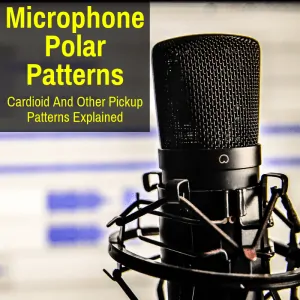 Do you keep coming across terms like cardioid or supercardioid?
Do you keep coming across terms like cardioid or supercardioid?
Those are two types of microphone pickup patterns and I realize reading that probably doesn’t clear much up.
But we’ll take care of that.
Microphone patterns show the zones around the microphone where that mic picks up sound well and where it does not pick up sound at all.
Depending on your needs, you might need a mic that only picks up sound from a source directly in front of it and blocks out sound coming from all other directions.
A mic like this might be great for a singer performing live on stage for example.
Whatever your needs, there is a mic or a combination of mics that will meet those needs.
But you need to know the different pickup patterns for mics and what their best uses are, before you can decide on the right one.
Table of Contents
Microphone Polar Patterns: The 5 Most Common
The following polar pickup patterns are the five most common ones you will encounter. I’ll explain exactly how each one picks up sound and for which uses it is best suited.
Cardioid Mic Pattern
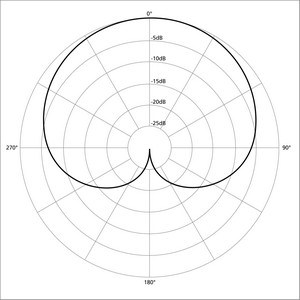
A microphone with a cardioid pickup pattern only picks up sound from sources located in front of the mic and minimizes any sounds coming from behind. This makes them great for studio recording, even in rooms with poor acoustics.
And since cardioid mics pick up nothing from behind, you can easily place monitor speakers directly behind them and get no feedback. One of the best cardioid mics available is the TLM 103.
Recommended For
Microphones with cardioid polar patterns are perfect for a single sound source, like one singer or speaker. They work especially well in these situations:
- studio recording (singing, rapping or talking)
- public speaking
- live performances
Supercardioid Polar Pattern
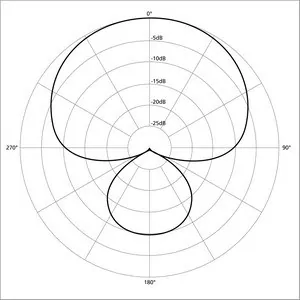
Cardioid vs Supercardioid
A supercardioid mic picks up sound directly in front and also some sound from the rear. A cardioid mic picks up nothing from the rear, but is not as narrowly focused toward the front.
This means a supercardioid mic is ideal for a single sound source in a loud environment, because it does a great job of blocking out all sounds that aren’t coming directly from the front. But, because it also captures sound in the rear, you have to be careful not to place monitoring speakers directly behind the mic, like you can with a regular cardioid mic.
Hypercardioid Polar Pattern
The hypercardioid pattern takes the supercardioid one step further. It is even more focused toward the front, blocks out anything from the sides and picks up more sound from the rear.
As such, a hypercardioid microphone is used mainly in loud environments where ambient noise needs to be blocked out. Because the pickup zone is so narrow and it picks up more sound from the rear than other cardioid mics, special care needs to be taken with mic placement. More info on this pattern here.
Omnidirectional Polar Pattern
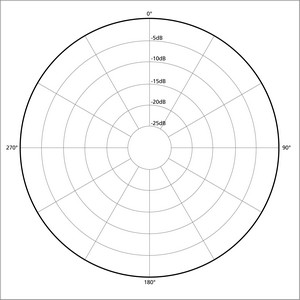
Obviously, this means you will pick up any sound in the environment. This makes for a very natural-sounding recording, and is great if you are trying to capture everything around you or a multitude of sources at once, like a complete orchestra.
The omnidirectional microphone pattern is not well-suited for use with a single sound source, like one speaker or singer singing into the mic.
It would only make sense if you are purposely trying to capture every other sound in the environment along with the single source. For that reason, cardioid mics are much more commonly used these days.
Recommended For
What is an omnidirectional microphone used for? Basically, you use one when you want to capture every sound that is in the area. For example, if you are recording an entire orchestra or if you are recording drums in a drum room. The omni polar pattern is also good for talk shows or movie or TV sets where only one mic is in use, rather than each person having their own mic.
Figure 8 Pattern
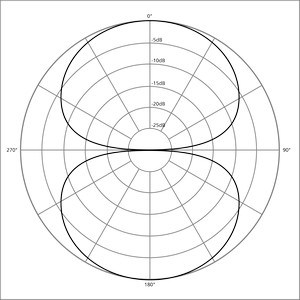
Recommended For
The most common uses for mics with a figure eight pickup pattern are for stereo recording and if you want maximum isolation of off-axis sounds. Figure eight mics allow you to isolate instruments that are positioned close to each other, since these mics pick up no sound whatsoever from the sides.
Microphone Polar Patterns Explained: Final Thoughts
There are other pickup pattern, but these 5 are the most common. Almost every microphone you find will have one of these polar patterns. Hopefully you now know the difference between them and which one is best suited for your needs.
Please let me know in the comments below if you have any questions or comments concerning microphone polar patterns.
Recommended Reading
- Microphones: Polar Pattern / Directionality on shure.eu
- What are a microphone’s polar patterns? on rode.com
Hi Camila, would the omni-directional mic be best for two (or three) singers and an acoustic guitar (and possibly two or three other instruments at times)?
You’ll probably want several mics for this, ideally one for each instrument and singer, though singers can share mics.